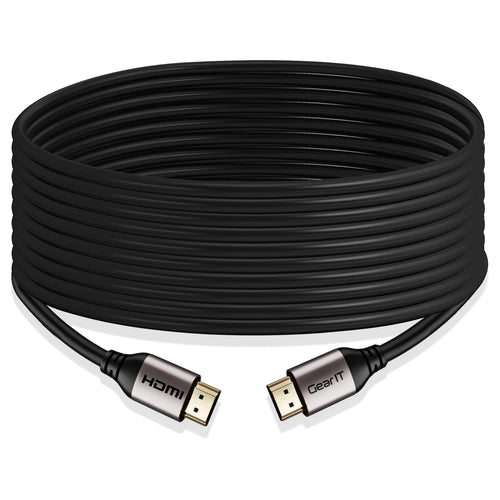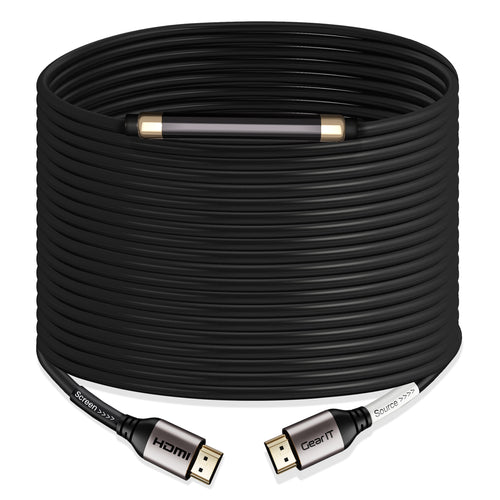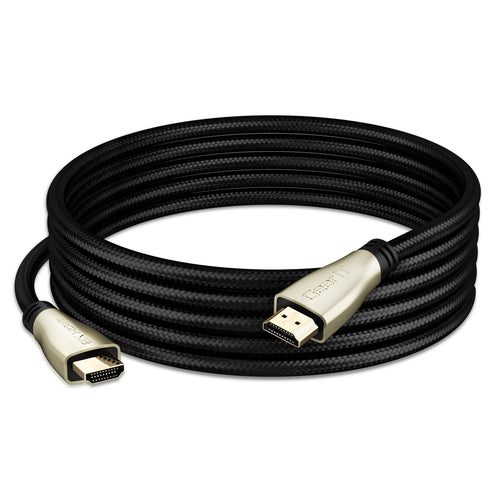HDMI cables have a length limit, with signal quality declining over longer distances. For runs over 25 feet, use high-quality cables with signal boosters or active HDMI options to maintain 4K or 8K performance without loss.
Upgrade to GearIT’s premium HDMI cables for long-lasting, high-quality connections:
Shop GearIT now for the best HDMI cables and enjoy crystal-clear visuals at any length! 🎥⚡

When setting up your home theater or connecting devices, knowing the limits of HDMI cable length is important. Standard HDMI cables can transmit signals reliably up to 25 feet (7.6 meters), which is enough for most home setups. If you need to connect devices farther apart, you can use active cables, fiber optic cables, or HDMI extenders to reach up to 300 feet without losing signal quality.
Choosing the right type of HDMI cable can affect your viewing experience. Different cables support various resolutions and bandwidths, which can change the clarity of your images and sound. Understanding these limits helps you get the best performance from your HDMI connections, whether you’re upgrading your entertainment system or setting up a conference room.
What is the Simple Explanation of HDMI?
HDMI stands for High-Definition Multimedia Interface. It is a standard used for transmitting both audio and video signals through a single cable. This makes it easier to connect devices like TVs, computers, and gaming consoles.
There are different HDMI versions, each with its own features. For example, HDMI 1.4 supports 4K video, while HDMI 2.1 increases bandwidth for higher resolutions and refresh rates.

The HDMI Licensing Administrator oversees the development and licensing of HDMI technology. This ensures that all devices using HDMI comply with the standards for quality and performance.
When considering cable length, the quality of your HDMI signal can be affected. For standard HDMI cables, lengths up to 25 feet are often reliable for maintaining good signal quality. If you plan to use high resolutions, it's best to keep the length under 10 feet (3 meters) to avoid any issues.
Using a longer cable without proper quality can lead to signal degradation, which affects the clarity of both audio and video. Always check your cable type and version to ensure it meets your needs, especially for high-definition content.
HDMI Cable Length Basics
Understanding HDMI cable length is crucial for maintaining signal quality and ensuring compatibility with your devices. Different factors can affect the maximum length of the cable you can use without compromising the performance or resolution of your setup.
Definition and Importance
An HDMI cable is used to connect devices like TVs, computers, and gaming consoles. Its length refers to how far the cable can run between the source and display.
The importance lies in the cable's ability to transmit high-quality audio and video. Longer cables can lead to signal degradation, which may result in lower resolution or interruptions in the signal. Knowing the right length ensures you get the best possible experience without losing quality.
Factors Influencing Cable Length

Buy 🛒: GearIT 8K Premium Braided HDMI 2.1 Cable
Several key factors influence how long an HDMI cable can be effective. These include:
✔️ Cable Type: There are standard, high-speed, and active HDMI cables. Each type has different capabilities.
✔️ Signal Quality: HDMI cables have different levels of shielding and construction. Higher quality cables can sometimes handle longer distances without significant loss in quality.
✔️ Resolution: As resolution increases (like 4K), the maximum length of the cable generally decreases. Higher resolutions require better signal preservation.
In general, passive cables are limited to about 50 feet for 1080p connections. For 4K signals, you should keep it under 25 feet.
HDMI Standard Length and Limitations
The standard length for an HDMI cable is often around 6 feet (1.8 meters), but cables can be longer, up to 50 feet. However, lengths beyond this come with limitations.
For standard HDMI cables, signal loss can occur beyond 25 feet for 4K resolution, causing pixelation or static. To extend the length, you can consider:
- Active HDMI Cables: These can amplify the signal and carry it over longer distances effectively.
- HDMI Extenders: These devices boost the signal further, allowing runs of up to 300 feet using Ethernet cables.
When selecting a cable, ensure that you check its specifications to match your setup needs.
What Is the HDMI Cable Length Limit?
When using HDMI cables, the general rule is to keep them under 50 feet. Within this range, you typically won’t experience any noticeable signal degradation.
If you need to use a cable longer than 50 feet, consider these points:
- Signal Quality: Beyond 50 feet, the quality of both picture and sound can decrease. This happens because the signal weakens the farther it travels.
- Active Cables: For longer distances, you might need an active HDMI cable with a built-in signal booster. These cables help maintain quality over longer runs.
- HDMI Over Ethernet: Another option is to use HDMI over Ethernet solutions. This method can transmit your signal over greater distances without significant loss.
Length Guidelines for Different Types
|
Cable Type |
Recommended Max Length |
|
Standard HDMI |
Up to 50 feet |
|
Copper HDMI |
15 to 25 feet |
|
Fiber Optic HDMI |
100 feet or more |
In practice, different HDMI versions, like HDMI 2.1, also affect performance. For example, HDMI 2.1 cables generally perform well up to 10 feet before facing signal degradation.
For your setup, it's crucial to choose the right type of HDMI cable based on the distance you need. This ensures that you enjoy the best audio and video quality.
How does HDMI Cable Length Affect Signal Quality?
The length of your HDMI cable can significantly impact signal quality. As you increase the cable length, the signal strength can decrease. This effect is known as attenuation.
1. Signal Loss
When the cable is longer, the HDMI signal has to travel further. This can lead to signal loss, which may result in a blurry image or audio drops.
2. Electromagnetic Interference (EMI)
Longer cables are also more susceptible to electromagnetic interference (EMI). EMI can come from nearby electronic devices and can disrupt the HDMI signal. If you notice flickering or distortion, cable length and interference could be the culprits.
3. Recommended Lengths
|
Cable Type |
Maximum Length |
Signal Quality |
|
Passive HDMI |
Up to 25 feet |
Good quality for short runs |
|
Passive HDMI |
Up to 50 feet |
Quality may vary |
|
Active HDMI |
Up to 100 feet |
Better signal over longer runs |
|
Optical HDMI |
Up to 300 feet |
Strong signal with minimal loss |
To maintain the best signal quality, choose a cable length that fits your setup. For longer distances, consider using active or fiber optic cables. These types can help maintain a strong signal over distance, reducing the impact of attenuation and interference.
Recommended HDMI Cable Lengths for Different Uses

Choosing the right HDMI cable length is crucial for getting the best performance from your devices. Each setup has its own ideal lengths to ensure high quality in audio and video.
HDMI Cable Lengths For Home Theaters
For home theaters, a recommended length is up to 15 feet. This distance suits most high-definition setups, ensuring clear video without signal loss.
If you need to extend beyond 15 feet, consider using an active HDMI cable or an HDMI extender. These solutions help maintain signal quality over longer distances.
To summarize:
- Ideal Length: Up to 15 feet
- Options for Longer Distances: Active cables or extenders
For Gaming Consoles
When setting up gaming consoles, keep your HDMI cable length to about 10 feet. This short distance helps reduce input lag, which is crucial for a smooth gaming experience.
Using a shorter cable allows for better signal integrity and faster response times.
If you find yourself needing a longer cable, choose a high-quality, well-shielded HDMI cable to minimize any potential lag or quality issues.
- Recommended Length: Up to 10 feet
- Importance of Short Cables: Reduces input lag
HDMI Cable Lengths For Office/
active hdmiConference Rooms
In office or conference room settings, you may need longer HDMI cables, often up to 50 feet. This length allows for flexible setup options, especially in larger spaces.
When using longer cables, opt for active HDMI cables. They help maintain audio and video quality over distances that passive cables cannot support effectively.
Make sure to test your setup to ensure there are no issues with signal loss.
Solutions for Extending HDMI Cable Length Beyond the Limit
You can extend the length of your HDMI cable in several effective ways. Each method has its advantages depending on your specific needs and setup. Here are some reliable solutions for extending HDMI cable length.
1. Active HDMI Cables
Active HDMI cables have built-in signal boosters that strengthen the HDMI signal. This can help maintain picture and sound quality over longer distances.
- Length Capability: These cables can typically extend up to 50 feet (15 meters) without significant loss of signal.
- Installation: They are usually plug-and-play, meaning you can easily connect them to your devices.
- Cost: While more expensive than standard cables, the investment often pays off in better performance.
Active HDMI cables are ideal for situations where you need a direct connection but want to avoid signal degradation.
2. HDMI Signal Extenders
HDMI signal extenders use external devices to amplify the HDMI signal. This method can significantly increase the distance you can cover.
- How They Work: These extenders connect to your HDMI source and display. They boost the signal to ensure clarity.
- Distance Capabilities: Many extenders can cover distances up to 300 feet (90 meters) using CAT5e or CAT6 cables.
- Versatility: This option is versatile and can work in various environments, making it suitable for both home and commercial use.
Consider HDMI signal extenders if you need to run your connection over long distances without sacrificing quality.
3. HDMI Over Ethernet (HDBaseT)
HDBaseT technology allows you to send HDMI signals over standard Ethernet cables.
- Distance: With this method, you can extend HDMI signals up to 300 feet (100 meters) using Cat6 cables.
- Simplified Wiring: This setup reduces the number of cables you need, making your installation cleaner.
- Additional Features: HDBaseT also supports other signals, like Ethernet and control signals, reducing the need for multiple runs.
HDMI 2.0 vs. HDMI 2.1: Does the Cable Version Matter for Length?
When choosing between HDMI 2.0 and HDMI 2.1, cable length limits are important to consider.
HDMI 2.0 Length Limit

Buy 🛒: GearIT 4K HDMI Cable CL3 Rated - HDMI 2.0b
HDMI 2.0 supports lengths up to about 15 meters for optimal video quality at standard resolutions. Beyond this range, you may face signal degradation, leading to poor picture quality.
HDMI 2.1 Length Limit
HDMI 2.1 cables can reach up to three meters for passive cables. Future developments may increase this to five meters. This version demands higher bandwidth, which can affect the signal over longer distances.
Bandwidth Considerations
- HDMI 2.0 offers a bandwidth of 18 Gbps. This bandwidth is sufficient for 4K video at 60Hz.
- HDMI 2.1 increases bandwidth to 48 Gbps. This is needed for higher resolutions and refresh rates, such as 8K at 60Hz.
Summary of Differences
- Signal Quality: The higher bandwidth of HDMI 2.1 aids in maintaining signal quality over longer distances.
- Cable Type: You might need active cables for longer distances with HDMI 2.1 to ensure good performance.
Conclusion
In conclusion, understanding the length limits of HDMI cables is crucial for maintaining a strong signal and high-quality audio and video. While most standard cables can perform well up to 15 meters, using active cables or extenders can help you go even farther without losing quality.
Always choose high-quality cables to ensure the best performance for your devices. If you're looking to upgrade or find the right HDMI cable for your setup, visit GearIT to explore a wide range of HDMI cables that meet your needs. Don't compromise on quality—get the best for your home entertainment system!
Frequently Asked Questions
Here are some common questions regarding HDMI cable lengths and their effects on performance. You’ll find answers to help you understand the limits and considerations for using HDMI cables.
How long can an HDMI cable be before loss?
HDMI cables can usually be up to 15 meters (about 50 feet) long without losing quality. If you go beyond this length, you might notice a drop in signal strength and picture quality. The quality of the cable and the devices connected can also affect how far you can go before experiencing loss.
What is the longest HDMI cable you can use?
The longest effective HDMI cable is generally around 15 meters. If you need a longer distance, you can use active HDMI cables or HDMI extenders, which can reach up to 30 meters or more without losing quality.
Is a 5M HDMI cable too long?
No, a 5-meter (about 16 feet) HDMI cable is a common length and is not too long. It should work well without any noticeable loss in quality, especially if you use a good quality cable.
Does the length of an HDMI cable affect quality?
Yes, the length can affect quality. Longer cables may lose signal strength, leading to poor picture or sound quality. However, cables up to 15 meters usually maintain good quality. Using high-quality cables can help reduce signal loss over longer distances.
How can you tell if your HDMI cable is bad?
You might know your HDMI cable is bad if you see a blank screen, flickering images, or hear poor audio. If the cable is damaged, look for signs like frayed ends or bent connectors. Testing the cable with different devices can help you find out if the cable is the problem.























































